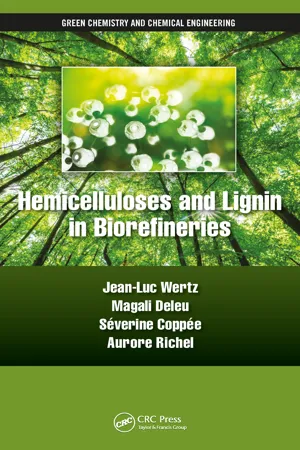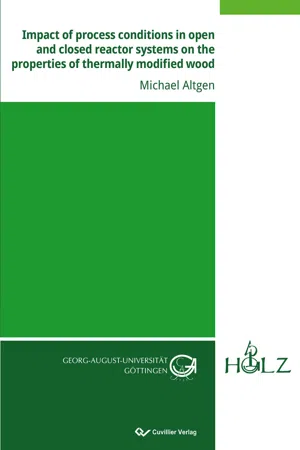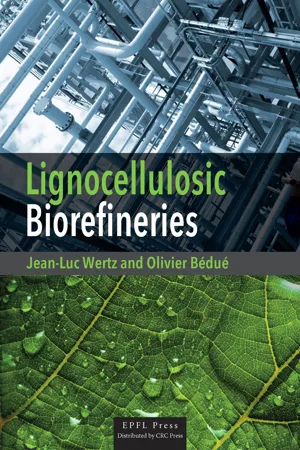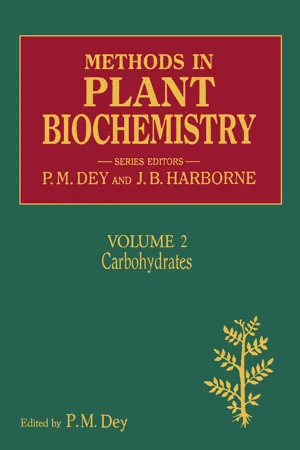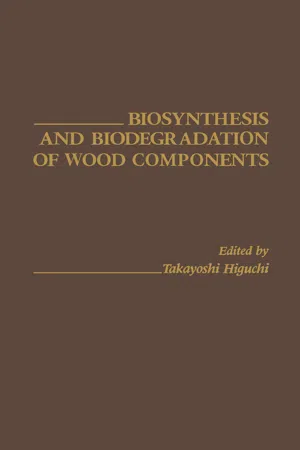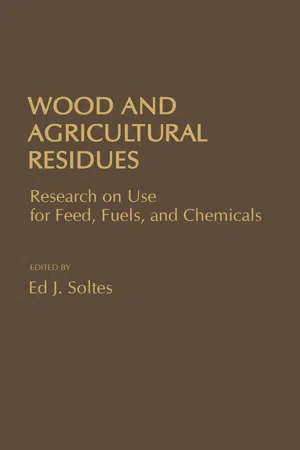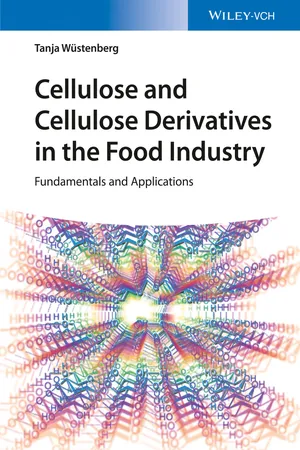Chemistry
Cellulose
Cellulose is a complex carbohydrate found in the cell walls of plants. It is composed of long chains of glucose molecules linked together, providing structural support to plant cells. Cellulose is a key component of dietary fiber and is widely used in the production of paper, textiles, and biofuels due to its abundance and renewable nature.
Written by Perlego with AI-assistance
Related key terms
1 of 5
11 Key excerpts on "Cellulose"
- eBook - PDF
- Monica Ek, Göran Gellerstedt, Gunnar Henriksson, Monica Ek, Göran Gellerstedt, Gunnar Henriksson(Authors)
- 2009(Publication Date)
- De Gruyter(Publisher)
71 Q `ÉääìäçëÉ ~åÇ `~êÄçÜóÇê~íÉ `ÜÉãáëíêó Gunnar Henriksson and Helena Lennholm KTH, Department of Fibre and Polymer Technology 4.1 Introduction 72 4.2 Carbohydrate Chemistry 72 4.2.1 Common Monosaccharides 73 4.2.2 Modified and Branched Monosaccharides 76 4.2.3 Cyclic Structures 78 4.2.4 The Glycosidic Bond 83 4.2.5 Di-, Oligo- and Polysaccharides 84 4.2.6 Carbohydrate Reactions 87 4.3 Occurrence and Function of Cellulose 88 4.4 Primary Structure of Cellulose 89 4.5 Secondary Structure of Cellulose 90 4.5.1 Hydrogen Bond Pattern 90 4.5.2 Interaction of Cellulose Sheets 91 4.5.3 Cellulose Ia and Ib 91 4.5.4 Shape of Fibrils 91 4.6 Other Crystalline Forms of Cellulose 93 4.7 Biosynthesis 94 4.7.1 Terminal Complexes Synthesize Cellulose 95 4.7.2 Control over Fibrilar Angle 97 4.8 Super Fibrilar Organization of Cellulose 97 4.9 Reactivity and Properties of Cellulose 98 4.10 Further Reading 99 4.10.1 General literature 99 4.10.2 Ph.D. Theses 99 72 QKN fåíêçÇìÅíáçå In this and the following chapters, the main components of the woody cell walls, Cellulose , hemiCellulose , lignin and extractives , will be described from a chemical perspective. First out is Cellulose 1 , which is normally the main component in the cell walls of all true plants. This and the abundance of plant material make Cellulose the outstandingly most common bio-compound on earth. Although its chemical structure is very simple, very long 2 unbranched chains of glu-cose, it displays various special properties that are of great scientific and technical interest. However, Cellulose, as well as different types of hemiCelluloses, belongs to the large group of biomolecules, the carbohydrates , which play central roles in all forms of life. Before the struc-ture, biosynthesis and properties of Cellulose are discussed, an introduction to carbohydrate chemistry is given. - eBook - ePub
- Jean-Luc Wertz, Magali Deleu, Séverine Coppée, Aurore Richel(Authors)
- 2017(Publication Date)
- CRC Press(Publisher)
3 Cellulose, the Main Component of BiomassBefore dealing with hemiCelluloses and lignin, it seems useful to give an update on Cellulose, the major cell wall component, which interacts strongly with the two other major cell wall components. Some of the features of Cellulose will serve for polysaccharides in general and their sugar monomers. The chapter will be devoted to its structure, its biosynthesis, and its enzymatic hydrolysis. After an introduction on bioeconomy and biorefineries, a chapter devoted to carbohydrate-active enzymes and one devoted to Cellulose, the reader will be able to discuss fruitfully hemiCelluloses and lignin.As early as in 1838, Anselme Payen1 established that the fibrous component of all higher plant cells had a unique chemical structure, which he named Cellulose.2 Cellulose is the main molecule in cell walls of higher plants. Cellulose is also produced by some algae, bacteria, fungi, protozoans, and animal tunicates. There is more Cellulose in the biosphere than in any other substance. The macromolecular nature of Cellulose was demonstrated toward 1930. It was so established that Cellulose is a polymer of glucose units. The chemical composition and conformation of Cellulose chains combined with their hydrogen bonding system are responsible for their tendency to form crystalline aggregates.3.1 STRUCTURE3.1.1 MOLECULAR STRUCTUREThe Cellulose molecule is a linear polymer of D-anhydroglucopyranose units linked together by β-1,4-glucosidic bonds (Figure 3.1 ). In other words, it is a β-1,4-D-glucan.The numbering of the carbon atoms in the ring is shown in Figure 3.1 , with two attached oxygen atoms at C1, hydroxyl substituents at C2 and C3, one attached oxygen atom at C4, and one hydroxymethyl group at C5. The positions 1 and 4 are involved in the interunit linkage. C1 is an acetal center along the whole chain except for the right-hand end where it is a hemiacetal center with inherent reducing properties. Thus, Cellulose, as all 1,4-linked glucans, has one reducing end - (Author)
- 2016(Publication Date)
- Cuvillier Verlag(Publisher)
The polysaccharides consist mainly of Cellulose (40-45%) and hemiCelluloses (15-25%), as well as of small proportions of starch and pectin (Rowell et al. 2005). The chemical composition differs between the wood species. In general, softwood species contain larger amounts of lignin, but lower amounts of hemiCelluloses than hardwood species. Furthermore, the chemical compositions of lignin and hemiCelluloses differ in softwoods and hardwoods, while Cellulose is a uniform component in all wood species (Fengel and Wegener 1984 pp. 26). The three main polymers of the wood cell wall are briefly described below. Cellulose is a linear high-molecular weight polymer consisting exclusively of D-glucopyranose units that are linked together by ß-(1 o 4)-glucosidic bonds. The repeating unit of the Cellulose chain is a cellobiose unit, in which one of the two glucose units is turned around its C1-C4 axis of the pyranose ring. The Cellulose chain has a reducing (C1-OH) and a non-reducing end (C4-OH) (Fengel and Wegener 1984 pp. 67). The size of the chain is usually specified as degree of polymerization (DP), which is the molecular weight of the Cellulose chain related to the molecular weight of one glucose unit. For wood Cellulose, an average DP of at least 9,000-10,000 is expected. Within the wood cell wall, Cellulose is in a semi-crystalline state. Cellulose molecules have a tendency to form intra- and intermolecular hydrogen bonds and aggregate to microfibrils. These microfibrils contain highly ordered Dieses Werk ist copyrightgeschützt und darf in keiner Form vervielfältigt werden noch an Dritte weitergegeben werden. Es gilt nur für den persönlichen Gebrauch. General introduction 2 crystalline regions with a high packing density, as well as less ordered non-crystalline regions with a lower packing density. Up to 65 % of the wood Cellulose exists as crystalline Cellulose (Rowell et al. 2005).- eBook - PDF
- Jean-Luc Wertz, Olivier Bédué(Authors)
- 2013(Publication Date)
- EPFL PRESS(Publisher)
Chapter 4 Cellulose, the Predominant Constituent of Biomass 4.1 Introduction Lignocellulosic biomass, or simply biomass, is chiefly composed of Cellulose, hemiCelluloses and lignin. Cellulose will be reviewed in the present chapter, its hydrolysis in Chapter 5, and hemiCelluloses and lignin in Chapter 6. For each biopolymer, its struc- ture, its biosynthesis, its structure and function in plant cell walls, its degrada- tion, and its properties and applications will be described. Three structural levels will be analyzed for Cellulose: n the molecular level; n the supramolecular level, which involves the arrangement of molecules into crystals; n the morphological (or ultrastructural) level, which involves the organiza- tion of the crystals into microfibrils, layers, cell walls, tissues, or other cel- lulose morphologies. Lignocellulosic Biorefineries 124 Then, the biosynthesis of Cellulose will be related to the structure of native cel- lulose. Finally, the properties and applications of Cellulose will be described in relation with its three structural levels. 4.2 Structure 4.2.1 Molecular structure The Cellulose molecule is a linear polymer of D-anhydroglucopyranose units linked together by β-1,4-glucosidic bonds (Figure 4.1). In other words, it is a β-1,4-D-glucan. The pyranose rings are in the energetically favorable [4] C 1 chair conformation. The conventional numbering of the carbon atoms in the ring is shown in Figure 4.1, with two attached oxygen atoms at C1, hydroxyl substituents at C2 and C3, one attached oxygen atom at C4, and one hydroxymethyl group at C5. The positions 1 and 4 are involved in the inter-unit linkage. O1 is the oxygen atom of the glycosidic bond, O5 that of the ring, O2 and O3 those of the secondary alcohols and O6 that of the primary alcohol. C1 is an acetal centre along the whole chain except for the right-hand end, where it is a hemiacetal centre with inherent reducing properties. - eBook - PDF
- J. B. Harborne(Author)
- 2012(Publication Date)
- Academic Press(Publisher)
Today, many industrial companies and many academic research groups are devoted to Cellulose chemistry. It is not surprising that there has been a proliferation of publications dealing with the fundamentals of Cellulose chemistry and biogenesis, the 8. Cellulose 293 physical and mechanical properties of Cellulose and its derivatives as well as its biological and chemical degradation. From the enormous number of publications, reviews and specialised books about Cellulose, only a few being of general interest can be cited (Brown, 1982; Wilke et aL, 1983; Burchard, 1985; Kennedy et aL, 1985; Nevell and Zeronian, 1985; Young and Powell, 1986; Fan et aL, 1987). II. IMPORTANCE AND SOURCES OF Cellulose The occurrence of Cellulose is remarkably general in terrestrial plants showing always the same structure. No other cell-wall polysaccharide with an identical structure is known to be so widespread. The chemistry and structure of pectins and hemiCelluloses is known to be variable between the different plant species. Cellulose is an important component of several fungi and some bacteria (Aronson, 1965) and marine animals such as tunicates (Wardrop, 1970). It may even be synthesised as an abnormal constituent in animal tissue (Toriumi et aL, 1972). The Cellulose-containing cell-wall structures are dynamic in shape, in their specific composition and in their properties, which may constantly change in response to endogenous or exogenous events (Franz, 1972). It is well documented that Cellulose is deposited as microfibrils, these being the main structural elements of a cell wall. Besides the mechanical strength of the plant cell, Cellulose is a protective component against external attack by mechanical forces or microorganisms. The different sources of Cellulose in various biological materials have determined the specific uses of this biopolymer. Textile fibres in general are not isolated from woody tissue. - Takayoshi Higuchi(Author)
- 2012(Publication Date)
- Academic Press(Publisher)
V. Biosynthesis of Cellulose Cellulose is the most abundant carbohydrate in nature and the most abundant compound of plant cell walls. It makes up the basic structural material of the cell walls of all higher land plants and is also found in some algae. In addition, it is synthesized by a few bacteria. Cellulose is a /3(1—>4)-linked D-glucan having a degree of polymerization of about 10,000. The glucan chains line up in a parallel arrangement to form ele-mentary fibrils. The Cellulose microfibril has a well-defined crystalline structure, but how the chains associate to give the crystalline arrays and how the microfibrils are deposited to give a coherent cell wall are poorly understood. In addition, almost nothing is known about how Cellulose chains are initiated or terminated, nor whether the synthesis of primary cell wall Cellulose is mediated by the same enzyme system and/or the same mechanism as secondary cell wall Cellulose. Essentially, three main approaches have been used to try to answer fundamental questions about Cellulose synthesis, orientation, and termi- 6. BIOSYNTHESIS OF CELL W A L L POLYSACCHARIDES 125 nation. In one case, autoradiographic techniques with labeled sugars have been coupled with electron microscopy. While those techniques can show some synthetic reactions as well as ultrastructure and localization, it can-not tell us anything about the mechanism of polymerization or sorting. Furthermore, when one uses labeled sugars as precursors, the label is not specific for Cellulose, but will label many cell-wall polysaccharides as well as other materials. Another approach to studying Cellulose biosynthesis and translocation is by cell-fractionation technique. If cell fractionation is coupled with labeling studies and chase experiments, it should be possible to follow the movement of Cellulose or some of its precursors or interme-diates.- eBook - PDF
Wood a Agricultural Residues
Research on Use For Feed, Fuels, and Chemicals
- Ed Soles(Author)
- 2012(Publication Date)
- Academic Press(Publisher)
THE STRUCTURE OF Cellulose: RECENT DEVELOPMENTS Rajai H. Atalla Chemical Sciences Division The Institute of Paper Chemistry Appleton, Wisconsin I. INTRODUCTION The largest fraction of plant cell wall matter consists of a variety of polysaccharides with backbones predominately consist-ing of 3 1,4-linked monosaccharides. The dominant one among these is the $ 1/4 homopolymer of anhydroglucose, Cellulose, shown schematically below. It is the primary structural compo-nent responsible for much of the mechanical strength of the cell wall. Its structural properties derive from its ability, unusual for a polysaccharide, to aggregate into semicrystalline domains even in an aqueous environment. The stability of aggregation into crystalline domains imparts to Cellulose many of the proper-ties that make it an important raw material. However, this stability of aggregation is also responsible for its resistance to dissolution and to digestion by chemical or biological methods. More effective utilization of wood and agricultural residues is dependent, in most instances, on altering the state of aggrega-tion to render the Cellulose more accessible to hydrolytic agents. In this chapter we consider some aspects of this problem. We first review our current understanding of the most common states of aggregation of Cellulose, with emphasis on those occurring in native tissue. We then consider briefly some of the methods fre-quently used to alter the states of aggregation in ways that enhance susceptibility to digestion. CH 2 OH Copyright © 1983 by Academic Press, Inc. WOOD AND AGRICULTURAL RESIDUES 5 9 All rights of reproduction in any form reserved. ISBN 0-12-654560-X 60 RAJ AI H. ATALLA II. STATES OF AGGREGATION The different states of aggregation of Cellulose have generally been described in terms of two conceptual frameworks. The first is the one used for semicrystalline polymers; the other is that for polymorphic crystalline solids. - eBook - ePub
Cellulose and Cellulose Derivatives in the Food Industry
Fundamentals and Applications
- Tanja Wuestenberg(Author)
- 2014(Publication Date)
- Wiley-VCH(Publisher)
As a naturally occurring polymer, Cellulose always contains small quantities of other constituents in addition to glucose (>99%). These substances are formed during photosynthesis of the plants and are directly incorporated partially into the Cellulose molecules or placed on the surfaces of the Cellulose molecules. This results, for example, in lignin–Cellulose complexes.Most of the changes in molecular structure, however, result from secondary reactions such as hydrolytic or oxidative processes that occur while the Cellulose molecules are extracted or isolated from their natural sources. Cellulose always contains carboxyl groups. In wood pulp, there is one -COOH group per 100–1000 anhydroglucose units (AGU). In cotton, one carboxyl group per 100–500 AGU can be found [10].Figure 3.4 illustrates where Cellulose is localized in a plant.Biological origin of the Cellulose in the cell wall of plants.Figure 3.4Figure 3.5 shows a cross-section through the plant cell wall.Cross-section through the cell wall of plants.Figure 3.5In tree wood, Cellulose is an essential part of the ingenious sophisticated fibre-reinforced composite, with long stiff Cellulose chain molecules being organized in thin fibrils and thereby holding the entire plant reticulum. The hydrophobic lignin takes on the task of a wrapping material [10].The polyoses (also known as hemiCelluloses) function as a binding agent that is positioned like a flexible unit between lignin and Cellulose as well as in between the individual Cellulose fibrils. Figure 3.6 displays, hierarchically, how the plant cell wall is built up from the glucose to the Cellulose.Table 3.4Overview of the hierarchy of structure elements from glucose to the Cellulose backbone of the plant cell wall [9]. Reprinted with kind permission of Dr. Erich Gruber.Figure 3.6 - eBook - PDF
- Alistair M. Stephen, Glyn O. Phillips(Authors)
- 2016(Publication Date)
- CRC Press(Publisher)
Albrecht, Ullmann’s Encyclopedia of Organic Compounds , 5th ed., A5, VCH Publishers, New York, 1986, p. 325. 3. D. Klemm, B. Heublein, H.-P. Fink, and A. Bohn, Cellulose: fascinating biopolymer and sustain-able raw material, Angew. Chem. Int. Ed. 44 :3358 (2005). 4. M. Tenkanen, M.-L. Niku-Paavola, M. Linder, and L. Viikari, Cellulases in food processing, Food Sci. Technol . ( New York ) 122 :771 (2003). 5. S. Malherbe and T.E. Cloete, LignoCellulose biodegradation: fundamentals and applications, Rev. Environ. Sci. Technol. 1 :105 (2002). 6. M. Kuwahara, Microbial conversion of lignocellulosic resources by the utilization of lignolytic activity of basidiomycetes, Cellulose Commun. 9 :62 (2002). 7. J.B. Russell and D.B. Wilson, Why are ruminant cellulolytic bacteria unable to digest Cellulose at low pH?, J. Dairy Sci. 77 :1503 (1996). 8. J.L. Black, Bioavailability: the energy component of a ration for monogastric animals, Feed Evaluation 133 (2000); Chem. Abstr. 136 :133986 (2002). 9. O. Almazan, L. Gonzalez, and L. Galvez, The sugarcane, its byproducts and co-products, Sugar Cane Int . 3–8 (2000). 10. G. Selman-Housein, M.A. Lopez, O. Ramos, E.R. Carmona, A.D. Arencibia, E. Menendez, and F. Miranda, Towards the improvement of sugar cane bagasse as raw material for the production of paper pulp and animal feed, Develop. Plant Genetics Breeding 5 :189 (2000). 11. D.G. Coffey, D.A. Bell, and A. Henderson, Cellulose and Cellulose derivatives, Food Polysaccharides and Their Applications (A.M. Stephen, Ed.), Marcel Dekker, New York, 1995, pp. 123–153. 12. R.H. Marchessault and P.R. Sundararajan, Cellulose, The Polysaccharides , Vol. 2 (G.O. Aspinall, Ed.), Academic Press, New York, 1983, p. 11. 13. D.R. Nobles, D.K. Romanovicz, and R.M. Brown, Jr., Cellulose biosynthesis in the cyanobacteria with implications for the origin of vascular plant synthase, Cellulose Commun. 8 :161 (2001). 14. S. Bielecki, A. Krystynowicz, M. Turkiewicz, and H. - eBook - PDF
- Peter Albersheim, Alan Darvill, Keith Roberts, Ron Sederoff, Andrew Staehelin(Authors)
- 2010(Publication Date)
- Garland Science(Publisher)
The strong est evidence is for hemiCelluloses covalently linked to lignin in wood. Three types of cross-links have been identified. Lignin may be linked to polysac charides through ester linkages (benzyl esters) between uronic acids of the polysaccharides and hydroxyl groups of lignin monomers. Ether bonds can link polysaccharides and lignin (benzyl ethers) through glucosyl or man- nosyl residues, and similarly glycosidic linkages can bond with phenolic residues or with hydroxyls of lignin side chains (phenyl glycosides). Ferulic acid, an important component of cell walls of grasses, is frequently esterified Figure 3.30 A hypothetical structure of lignin from a wood cell wall. This model is one of millions of alternative structures that could be formed from 2 0 monomeric lignin subunits with a composition similar to poplar. Most linkages are p-ether units. Me represents a methyl group (CH3). Subunits 1, 2, 3, 7, 9, 14, 15, 17, 18, and 20 are S units; 4, 5, 6 , 8 , 10, 11, 12, 13, 16, and 19 are G units. p-O-4 units predominate, except for unit 4 (5-0-4), unit 11 (oc-O-4 and p-5) (a-O-4 and p-5), and 14-15 linked as pp. One branch point is shown as a 4-0-5 linkage between syringyl unit 4 (S) and guaiacyl unit 9. (After J. Ralph et al., Phytochem. Rev .: 3:29-60, 2004.) Lignin 103 104 Chapter 3 Biochemistry of the Cell Wall Molecules Figure 3.31 A model of a lignin polymer in spherical space. (A) A model of seven subunits connected by six different linkages (5-5, p-O-4, a-O-4, p-1, 4-0-5, cyclic p-O-4). Balls represent aromatic rings, and sticks represent side chains or groups. Short sticks are 4-OH, groups and propane side chains are longer. (B) Simulated development of macromolecular shape as a function of increasing polymer size. DP is the degree of polymerization ranging from 75 to 1200 subunits. (C) Lignin model of a spherical macromolecule of 1147 subunits containing 1247 bonds, 101 of which are intrachain cross-links. - eBook - PDF
- Jocelyn K. C. Rose(Author)
- 2009(Publication Date)
- Wiley-Blackwell(Publisher)
Xyloglucan, xylans, and mannans but not arabinogalactan are included under this chemical definition of hemiCelluloses. The structural similarity between hemiCellulose and Cellulose most likely gives rise to a conformational homology that can lead to a strong, noncovalent association of the hemiCellulose with Cellulose microfibrils. 1.7.2 Xyloglucan Xyloglucan is the most abundant hemicellulosic polysaccharide in the primary cell walls of non-graminaceous plants, often comprising 20% of the dry mass of the wall. Xyloglucan has a ‘cellulosic’ backbone consisting of 1,4-linked β -D -Glc p residues. Up to 75% of the backbone residues are branched, bearing α -D -Xyl p residues at O6. Many of the Xyl p residues bear glycosyl substituents at O2, thereby extending the side chain (Figure 1.2). The cellulosic backbone itself does not vary among xyloglu-cans from different plant species and tissues and only a limited number of xyloglucan side chain structures have been described. Therefore the structure of a xyloglucan molecule can be completely and unambiguously described by listing, in order, the pattern of side chain substitution for each Glc p residue in the backbone (see Figure 1.2; Fry et al ., 1993). For example, an uppercase G designates an unbranched Glc p residue and a Glc p residue bearing a single α -D -Xyl p residue at O6 is designated by an uppercase X. A Glc p residue bearing the trisaccharide α -L -Fuc p -(1,2)-β -D -Gal p - COMPOSITION AND STRUCTURE 15 (1,2)-α -D -Xyl p at O6 is designated by an uppercase F. Thus, the most commonly occurring, fucose-containing xyloglucan sequence is XXFG (Figure 1.2). Xyloglucans are classified as ‘XXXG-type’ or ‘XXGG-type’ based on the number of backbone glucosyl residues that are branched (Vincken et al. , 1997). XXXG-type xyloglucans have three consecutive backbone residues bearing an α -D -Xyl p substituent at O6 and a fourth, unbranched backbone residue.
Index pages curate the most relevant extracts from our library of academic textbooks. They’ve been created using an in-house natural language model (NLM), each adding context and meaning to key research topics.

